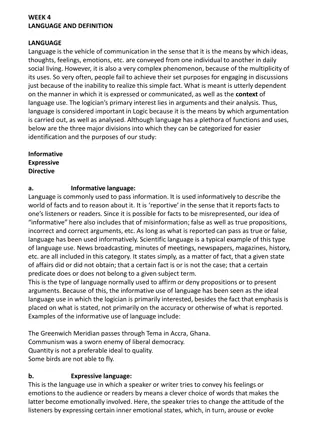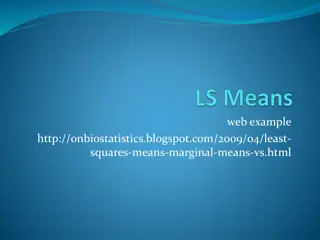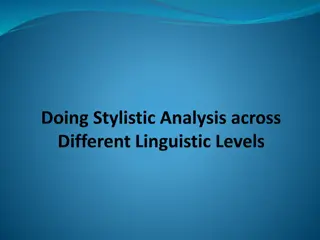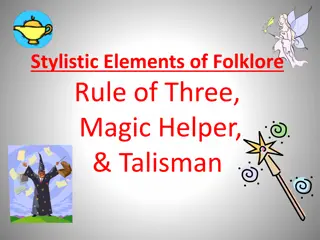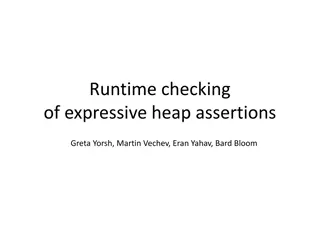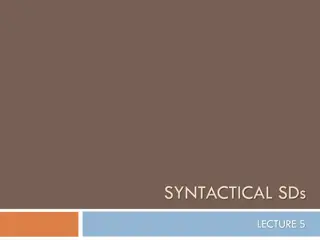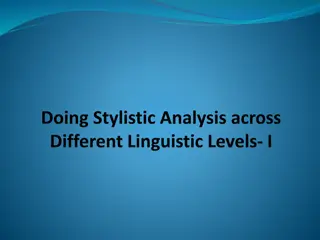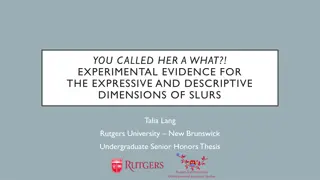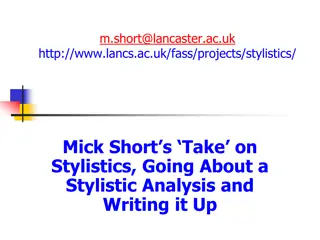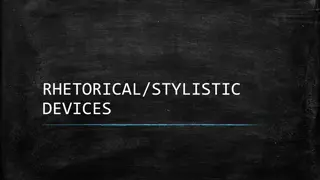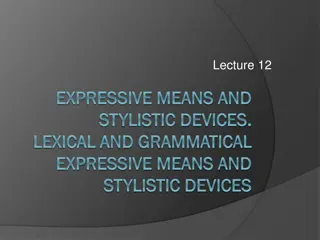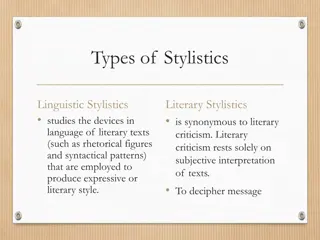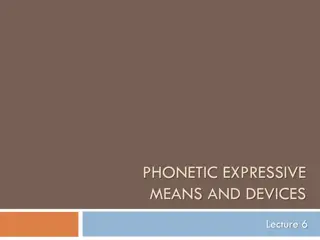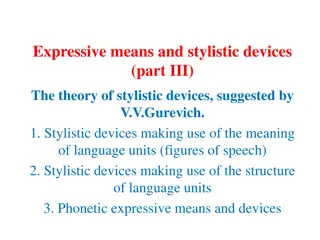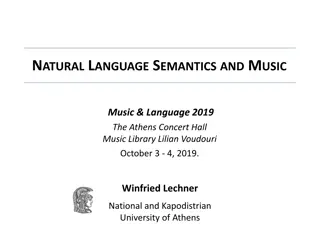Understanding Expressive Means and Stylistic Devices in Language
Expressive means and stylistic devices play a vital role in intensifying language utterances, encompassing phonetic, morphological, lexical, word-building, phraseological, and syntactical forms. These tools help evoke emotions, logical emphasis, and additional meaning in communication. By utilizing techniques such as pitch, stress, word choice, and sentence structure, writers and speakers can enhance the expressiveness of their language, creating a more impactful and engaging discourse.
Uploaded on Sep 09, 2024 | 0 Views
Download Presentation

Please find below an Image/Link to download the presentation.
The content on the website is provided AS IS for your information and personal use only. It may not be sold, licensed, or shared on other websites without obtaining consent from the author. Download presentation by click this link. If you encounter any issues during the download, it is possible that the publisher has removed the file from their server.
E N D
Presentation Transcript
Expressive Means and Stylistic Devices. Phonetic and Graphical Expressive Means and Stylistic Devices Lecture 11
11.1. Expressive Means and Stylistic Devices. 11.2. Phonetic Expressive Means and Stylistic Devices. 11.3. Graphical Expressive Means and Stylistic Devices.
Expressive Means and Stylistic Devices Expressiveness a kind of intensification of an utterance or a part of it. Emotiveness the emotions of writer or speaker. Expressiveness broader than emotiveness. Emotiveness occupiesa predominant position in expressiveness. Therearemedia in language, which aim at logical emphasis of a certainpartof utterance. Theyevoke no feelingsbutservethepurposeof verbal actualization ofthe utterance.
Expressive Means and Stylistic Devices Expressive Means phonetic, morphological, word-building, lexical, phraseological and syntactical forms which exist in language-as-a-system for the purpose of logical and/or emotional intensification of the utterance. All these forms have neutral synonyms. Phonetic expressive means: pitch, melody, stress, whispering, manner of speaking, pauses, etc.
Expressive Means and Stylistic Devices Word-building expressive means: suffixes and productive patterns of word formation. Lexical expressive means: words, which obtain inherent expressiveness, perceived without any context. There are words with emotive meaning only, words which have both referential and emotive meaning, slang, vulgar, poetic and archaic words, set- phrases and phraseological units. Morphological expressive means: grammatical forms (tenses, pronouns, articles, modal verbs) which obtain inherent expressiveness, perceived without any context. Syntactical expressive means: constructions, which reveal a certain degree of logical and emotional emphasis.
Expressive Means and Stylistic Devices Stylistic Device is a conscious and intentional intensification of some typical structure and/or semantic property of a language unit (neutral or expressive) promoted to a generalized status and thus becoming a generative model. Stylistic devices function in texts as marked units and always carry additional information. Most stylistic devices display an application of two meanings: the ordinary one, which has already been established in the language-as-a- system, and a special meaning which is attributed to the unit by text, i.e. a meaning which appears in the language-in-action.
Expressive Means and Stylistic Devices Example: The night has swallowed him up I. R. Galperin s classification based on the level- oriented approach: Phonetic expressive means and stylistic devices. Graphical expressive means and stylistic devices. Lexical expressive means and stylistic devices. Syntactical expressive means and stylistic devices.
Phonetic Expressive Means and SD Onomatopoeia the use of words whose sounds imitate those of an object or action: hiss, murmur. A message with an onomatopoeic word carries not only the logical information, but also supplies the vivid portrayal of the situation described. There are two varieties of onomatopoeia: Direct onomatopoeia words that imitate natural sounds, e.g. ding-dong, burr, bang, cuckoo. Indirect onomatopoeia a combination of sounds the aim of which is to make the sound of the utterance an echo of its sense. And the silken, sad, uncertain rustling of each purple curtain.
Phonetic Expressive Means and SD Alliteration the repetition of consonants, usually in the beginning of words, e.g., Muck and money go together; Safe and sound. Assonance the repetition of similar vowels, usually in stressed syllables. e.g. Dreadful young creatures squealing and squawking. Rhyme is the repetition of identical or similar terminal sound combination of words. Rhyming words are generally placed at a regular distance from each other. In verse they are usually placed at the end of the corresponding lines. Rhythm is the pattern of interchange of strong and weak segments. It's a regular recurrence of stressed and unstressed syllables that make a poetic text.
Graphical Expressive Means and SD Sound is foregrounded mainly through the change of its accepted graphical representation. This intentional violation of the graphical shape of a word used to reflect its authentic pronunciation is called graphon. Graphon effective means of supplying information about the speaker's origin, social and educational background, physical or emotional condition, etc.
Graphical Expressive Means and SD The main functions of graphon are: to express the author's attitude to the characters, e.g. butler Yellowplush impresses his listeners with the learned words pronouncing them as "sellybrated" (celebrated), "bennyviolent" (benevolent). to show the physical defects of the speakers, e.g. the stuttering "The b-b-b-b-bas-tud - he seen me c--c-c-c-coming , to convey the atmosphere of authentic live communication, of the informality of the speech act, e.g. "gimme" (give me), "lemme" (let me), "gonna" (going to), "gotta" (got to), etc.
Graphical Expressive Means and SD Graphical changes may reflect not only the peculiarities of pronunciation, but are also used to convey the intensity of the stress, emphasizing and thus foregrounding the stressed words. To such purely graphical means we should refer all changes of the type (italics, capitalization), spacing of graphemes (hyphenation, multiplication) and of lines, e.g. Help. Help. HELP ; He was grinning like a chim-pan-zee ; Alllll aboarrrrrd .





